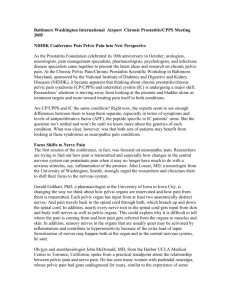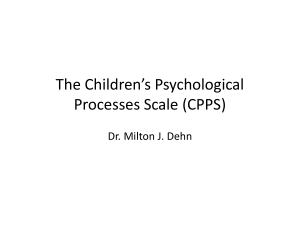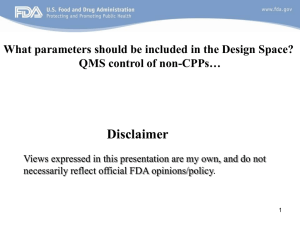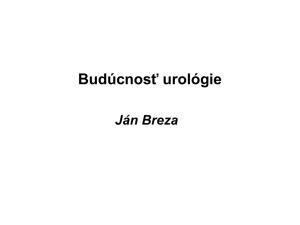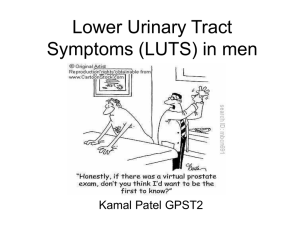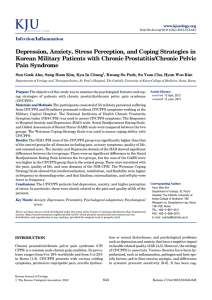Chronic Pelvic Pain Syndrome (CPPS or Chronic Nonbacterial
advertisement
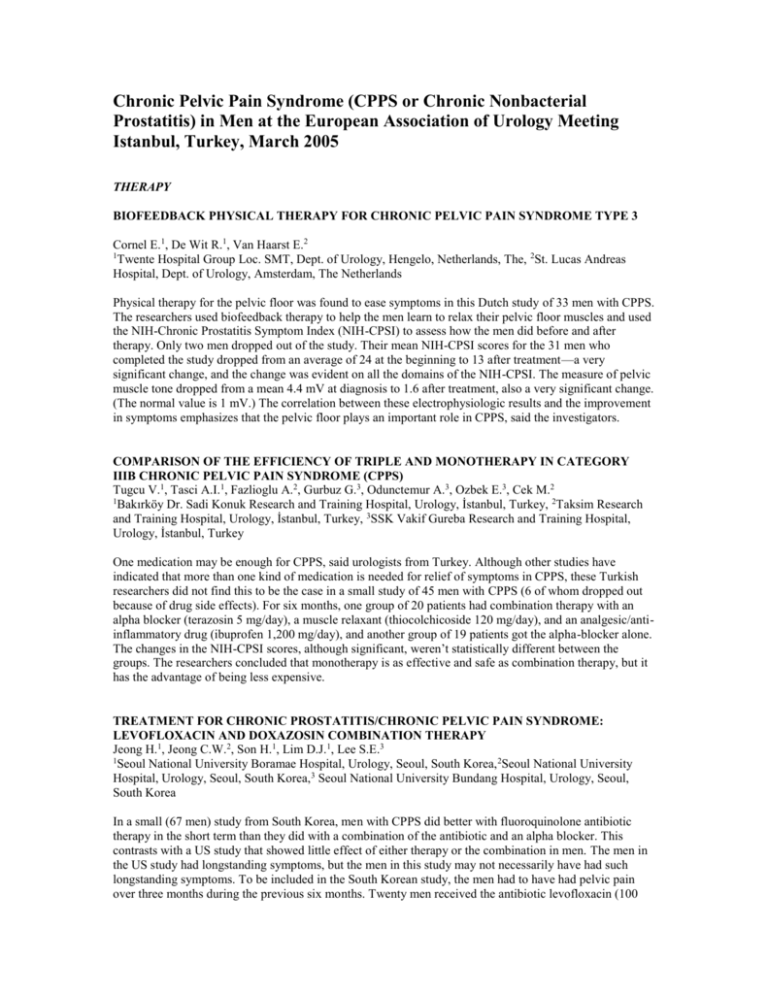
Chronic Pelvic Pain Syndrome (CPPS or Chronic Nonbacterial Prostatitis) in Men at the European Association of Urology Meeting Istanbul, Turkey, March 2005 THERAPY BIOFEEDBACK PHYSICAL THERAPY FOR CHRONIC PELVIC PAIN SYNDROME TYPE 3 Cornel E.1, De Wit R.1, Van Haarst E.2 1 Twente Hospital Group Loc. SMT, Dept. of Urology, Hengelo, Netherlands, The, 2St. Lucas Andreas Hospital, Dept. of Urology, Amsterdam, The Netherlands Physical therapy for the pelvic floor was found to ease symptoms in this Dutch study of 33 men with CPPS. The researchers used biofeedback therapy to help the men learn to relax their pelvic floor muscles and used the NIH-Chronic Prostatitis Symptom Index (NIH-CPSI) to assess how the men did before and after therapy. Only two men dropped out of the study. Their mean NIH-CPSI scores for the 31 men who completed the study dropped from an average of 24 at the beginning to 13 after treatment—a very significant change, and the change was evident on all the domains of the NIH-CPSI. The measure of pelvic muscle tone dropped from a mean 4.4 mV at diagnosis to 1.6 after treatment, also a very significant change. (The normal value is 1 mV.) The correlation between these electrophysiologic results and the improvement in symptoms emphasizes that the pelvic floor plays an important role in CPPS, said the investigators. COMPARISON OF THE EFFICIENCY OF TRIPLE AND MONOTHERAPY IN CATEGORY IIIB CHRONIC PELVIC PAIN SYNDROME (CPPS) Tugcu V.1, Tasci A.I.1, Fazlioglu A.2, Gurbuz G.3, Odunctemur A.3, Ozbek E.3, Cek M.2 1 Bakırköy Dr. Sadi Konuk Research and Training Hospital, Urology, İstanbul, Turkey, 2Taksim Research and Training Hospital, Urology, İstanbul, Turkey, 3SSK Vakif Gureba Research and Training Hospital, Urology, İstanbul, Turkey One medication may be enough for CPPS, said urologists from Turkey. Although other studies have indicated that more than one kind of medication is needed for relief of symptoms in CPPS, these Turkish researchers did not find this to be the case in a small study of 45 men with CPPS (6 of whom dropped out because of drug side effects). For six months, one group of 20 patients had combination therapy with an alpha blocker (terazosin 5 mg/day), a muscle relaxant (thiocolchicoside 120 mg/day), and an analgesic/antiinflammatory drug (ibuprofen 1,200 mg/day), and another group of 19 patients got the alpha-blocker alone. The changes in the NIH-CPSI scores, although significant, weren’t statistically different between the groups. The researchers concluded that monotherapy is as effective and safe as combination therapy, but it has the advantage of being less expensive. TREATMENT FOR CHRONIC PROSTATITIS/CHRONIC PELVIC PAIN SYNDROME: LEVOFLOXACIN AND DOXAZOSIN COMBINATION THERAPY Jeong H.1, Jeong C.W.2, Son H.1, Lim D.J.1, Lee S.E.3 1 Seoul National University Boramae Hospital, Urology, Seoul, South Korea, 2Seoul National University Hospital, Urology, Seoul, South Korea,3 Seoul National University Bundang Hospital, Urology, Seoul, South Korea In a small (67 men) study from South Korea, men with CPPS did better with fluoroquinolone antibiotic therapy in the short term than they did with a combination of the antibiotic and an alpha blocker. This contrasts with a US study that showed little effect of either therapy or the combination in men. The men in the US study had longstanding symptoms, but the men in this study may not necessarily have had such longstanding symptoms. To be included in the South Korean study, the men had to have had pelvic pain over three months during the previous six months. Twenty men received the antibiotic levofloxacin (100 mg three times/day), 22 received the alpha blocker doxazosin (4 mg/day), and 25 received the combination for 6 weeks. The differences between the groups were not apparent at two weeks, but at 6 weeks, the groups’ NIH-CPSI scores had dropped 56.8%, 24.4%, and 15.4%, respectively—significantly more in the levofloxacin group and with no statistical difference between the doxazosin and combination group. The researchers concluded that, in the short term, antibiotic treatment alone is the better therapy. THALIDOMIDE AS THERAPY FOR THE CHRONIC PELVIC PAIN SYNDROME (CPPS) Guercini F., Costantini E., Pajoncini C., Giannantoni A., Porena M. University of Perugia, Urology, Perugia, Italy Thalidomide may have activity in autoimmune disease, which is why it is being investigated as a therapy in Crohn’s disease and rheumatoid arthritis. Because CPPS may have an autoimmune origin, these Italian researchers tried the drug in a small group of patients with CPPS who also had abnormal levels of sperm cytokines, which are associated with autoimmunity. Fifteen patients received thalidomide 100 mg/day for four weeks and then 200 mg/day for another eight weeks, and another 15 received placebo. The investigators measured cytokines and NIH-CPSI scores before therapy and at 4, 12, and 16 weeks after therapy. Although cytokine levels were reduced in those with active treatment, the NIH-CPSI scores weren’t significantly different in the two groups at any of those times. Two patients—one in the treatment group and one in the placebo group—showed signs of peripheral neuropathy and were excluded from the study. CHRONIC PROSTATITIS/CHRONIC PELVIC PAIN SYNDROME RECURRENCE AFTER INITIAL EFFECTIVE PHYTOTHERAPEUTIC TREATMENT Reissigl A.1, Pointner J.1, Obwexer S.1, Wiunig C.1, Aigner M.1, Meyer-Venter R.1, Remzi M.2, Djavan B.2 1 LKH-Bregenz, Urology, Bregenz, Austria, 2AKH-Vienna, Urology, Vienna, Austria Initially encouraging results with Permixon (a preparation of saw palmetto sold in Europe) for CPPS didn’t hold up in the long term in a small Austrian study. Of the 72 men who started the study, the researchers were able to evaluate 55 after three years of therapy. After 6 months of treatment, 78 percent of the men had at least mild improvement (30 to 50 percent) in their Subjective Global Assessment and NIH-CPSI scores, and after 12 months 72 percent had that much improvement. But after three years, only 32 percent of the men had that much improvement. Also, after 6 months, 53 percent of men reported clear improvement (50 percent or better), and after 12 months 44 percent did so. But the percentage of men benefiting that much decreased to 19 percent after three years. PSA levels and prostate volume had increased slightly since the beginning of the study. Improvements in CPPS seen in the short term with monotherapy just don’t hold up over the long term, concluded these investigators. COOLED THERMOTHERAPY FOR CHRONIC ABACTERIAL PROSTATITIS - 2 YEARS AFTER TREATMENT Kastner C.1, Miller P.1, Fletcher H.1, Nelson C.1, Austin L.2 1 East Surrey Hospital, Urology, Redhill, United Kingdom, 2Urologix Inc., Clinical Research, Minneapolis, United States Good results with cooled transurethral microwave thermotherapy for CPPS hold up two years after treatment, according to these researchers. This therapy is also used for benign prostatic hyperplasia (BPH), but CPPS patients get more analgesia. The study started out with 39 patients with intractable CPPS at centers in both England and the United States. Now, two-year results are available for the 15 patients from an English hospital. Three of these patients requested repeat therapy, and symptom-free periods were longer after retreatment. One patient had symptoms recur episodically, and one had a severe acute episode. For the patients at the East Surrey Hospital site, the percentage of patients who had at least 50 percent improvement on the overall NIH-CPSI score was 57 at 6 months, 38 at 12 months, and 47 at 24 months. In the pain domain of the NIH-CPSI, the percentage of patients getting at least 50 percent improvement was 71 at 6 months, 62 at 12 months, and 67 at 24 months. In the urinary domain, the comparable figures were 36 percent at 6 months, 15 percent at 12 months, and 27 percent at 24 months. On the quality-of-life domain, the percentages were 47 at 6 months, 31 at 12 months, and 53 at 24 months. The numbers indicate that the results hold up over the long term, but the researchers called for a larger study with longer followup to make sure. EPIDEMIOLOGY PREVALENCE, CLINICAL SIGNIFICANCE AND MANAGEMENT OF MEN WITH BPH/LUTS AND PROSTATITIS-LIKE SYMPTOMS Nickel J.C.1, Elhilali M.2, Vallancien G.3 1 Queen’s University, Urology, Kingston, Canada,2 McGill University, Urology, Montreal, Canada,3 Institut Mutualiste Montsouris, Urology, Paris, France About one in five men with lower urinary tract symptoms (LUTS) typical of BPH likely have CPPS at the same time. To find out how common this situation is as well as how to manage it in real-life practice, these researchers from Canada and France did an open-label study of the alpha blocker alfuzosin in 4,857 sexually active men (mean age 63 years) with LUTS and had them complete a questionnaire related to pain and discomfort with ejaculation, which is a common symptom in CPPS but not BPH. The score related to ejaculation was weighted by both severity and how bothersome the symptoms were. The investigators found that 997 of the men (20.5 percent) had pain or discomfort with ejaculation, and 89.2 percent of those considered it to be a problem. The men who had this also had higher LUTS scores and were bothered more by their symptoms. In addition, 74.5 percent of these men had erectile dysfunction (ED), and 71.9 percent had reduced ejaculate compared with 59.6 percent and 57.4 percent, respectively, of men without the ejaculatory pain and discomfort. ED was considered a problem by 91.6 percent and reduced ejaculate by 80.8 percent of the men with ejaculatory symptoms compared with 78.5 percent and 57.6 percent, respectively, of men without that type of pain. After 6 months of treatment with the alpha blocker, men with pain and discomfort on ejaculation had as much or more improvement in LUTS, bother, and sexual dysfunction than did men who had no pain with ejaculation. PREVALENCE OF PROSTATITIS SYMPTOMS AND LOWER URINARY TRACT SYMPTOMS (LUTS) IN 1759 MEN USING VALIDATED QUESTIONNAIRES Hochreiter W.W.1, Madersbacher S.2, Temml C.3, Zbrun S.1, Wolfensberger P.1, Studer U.E.1 1 University of Bern, Department of Urology, Bern, Switzerland, 2Donauspital, Department of Urology, Vienna, Austria, 3City of Vienna, Department of Preventive Health, Vienna, Austria These Swiss and Austrian researchers also tried to estimate how common CPPS might be compared with BPH as well as uncover what the risk factors might be through a Vienna-based health screening project that included 1,759 men aged 20 to 80 years. To look for LUTS and prostatitis symptoms, the investigators used the CPSI and the International Prostate Symptom Score (IPSS). In addition, all participants underwent a detailed health examination, including physical assessment, evaluation of various lifestyle factors, medical history, and blood analysis. The median values on those scales increased with age—from 2.5 on the CPSI and 1 on the IPSS for men in their 20s to 5 on the CPSI and 7 on the IPSS for men in their 70s. Nine percent of all men had moderate to severe prostatitis symptoms, including 5.4 percent of men in their 20s, 6.3 percent of men in their 30s, 8.5 percent of men in their 40s, 11.7 percent of men in their 50s and 60s, and 13 percent of men in their 70s. Men with more severe prostatitis symptoms also complained of more severe LUTS, according to the IPSS scores. There was no correlation between common health risks, such as diabetes, coronary heart disease, hypertension, or overweight, and the degree of LUTS and prostatitis symptoms. In addition, there was no correlation with stress or consumption of alcohol, coffee, or spicy foods. PATHOPHYSIOLOGY AND BASIC RESEARCH ULTRASOUND EVALUATION OF BLADDER NECK COMPLEX ALTERATIONS IN CHRONIC PROSTATITIS/CHRONIC PELVIC PAIN SYNDROME Dellabella M., Milanese G., Muzzonigro G. Polytechnic University of the Marche Region, School of Medicine, Urology, Ancona, Italy Using ultrasound to look at the anatomy of the bladder neck area—from where the bladder narrows to empty into the urethra to the prostate—these Italian researchers found that some features are often different in men with CPPS from those in healthy men. Those differences may help researchers study the effects of drugs on CPPS. There were differences in prostate volume, hypoechoic periurethral zone volume, posterior prostate lip thickness, the bladder neck thickness, and detrusor (bladder muscle) thickness and in the presence of prostate hyperechoic anterior stroma. There were no differences in the occurrence of calcifications around the urethra. Some of these features might play a role in symptoms. For example, the investigators found correlations between the NIH-CPSI score and the hyperechoic periurethral zone as well as the posterior prostate lip thickness. THE STUDY OF KALLIKREIN-KININ SYSTEM COMPONENTS ACTIVITY IN PATIENTS WITH CHRONIC PELVIC PAIN SYNDROME Kogan M.1, Mikashinovich Z.2, Shangichev A.1, Chernogubova E.2, Belousov I.1 1 Rostov State Medical University, Department of Urology, Rostov On Don, Russia, 2Rostov State Medical University, Department of Biochemistry, Rostov On Don, Russia These researchers found changes in the kallikrein-kinin system in the blood and prostate tissue of men with CPPS compared with healthy men. The kallikrein-kinin system is important in the onset of inflammation. Components of this system aren’t found in prostate secretions of healthy men, but the investigators found them in prostate gland secretions in patients with CPPS. Activity of three different components of the system are from nearly three to four times higher in the inflammatory form of CPPS than in the noninflammatory form, and another is present in the inflammatory form but absent in the noninflammatory form. That’s evidence, the investigators believe, of inflammation and a disorder of the barrier between blood and prostate tissue. The full abstracts related to prostatitis are available on the UroToday website at: http://www.urotoday.org/prod/contents/confreport/article.asp?cat=confReport&sid=184&tid=397&aid=241 5

